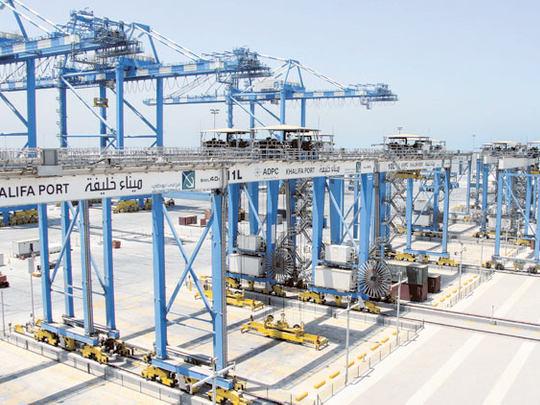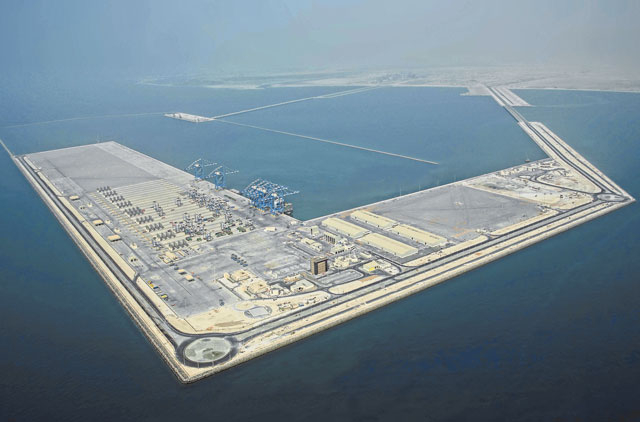
Abu Dhabi: In keeping with the Abu Dhabi Vision 2030, Khalifa Port, the multibillion dollar flagship project in Abu Dhabi adjacent to Khalifa Industrial Zone Abu Dhabi (Kizad), will be officially opened by President His Highness Shaikh Khalifa Bin Zayed Al Nahyan on Wednesday.
The port is designed to accommodate Mina Zayed’s traffic and Abu Dhabi’s trade growth as well as move truck traffic away from the city, Dr. Sultan Jaber, chairman of Abu Dhabi Ports Company (ADPC), told Gulf News earlier.
“Since more than 90 per cent of the world trade is conducted by the international shipping industry, this has prompted building advanced infrastructure that will contribute to the diversification of revenue sources, increased reliance on trade and increased capacities at ports,” Al Jaber said.
He added that Khalifa Port is one of the world’s most technologically advanced ports featuring the latest technology and designed to accommodate the world’s largest Post-Panamax ships.
“Phase one of the port will have an initial annual capacity of handling two million TEUs of container traffic and 12 million tonnes of general cargo. The cost up to Q4, 2012 is estimated to be Dh26.5 billion for phase one of Khalifa Port and Kizad Zone A,” Al Jaber added.
Annual container traffic
He stressed that by 2030, Khalifa Port will grow to a size where it can comfortably handle annual container traffic of 15 million TEUs and approximately 35 million tonnes of general cargo.
In reply to a question about how Khalifa Port would meet Abu Dhabi’s Vision 2030, Al Jaber said: “The Abu Dhabi 2030 vision is for non-oil products to contribute up to 60 per cent of the emirate’s GDP. Khalifa Port is a key enabler of Abu Dhabi’s 2030 Vision for diversification of the economy.”
He added: “Khalifa Port and Kizad are set to redefine the industrial landscape in the region and are expected to contribute 15 per cent of Abu Dhabi’s non-oil GDP by 2030.”
Al Jaber said that the construction of Khalifa Port as a modern gateway forms a core part of the Abu Dhabi Economic Vision 2030, where the development of ports and logistical hubs will play a vital role in the nation’s future prosperity.
He added that the UAE had been highly dependent on oil revenues for the past few decades and the government recognises that it must diversify the economy. Trade is a major pillar by which diversification can be achieved and ADPC promotes trade through its ports.
“In addition, the port serves as a dedicated enabler for Kizad, also developed by ADPC, and which will be one of the largest industrial zones in the world, offering its tenants easy access to markets, a low-cost operating environment and ease of doing business,” Al Jaber said.
Comparison to Mina Zayed
With regard to the benefits of the new port in comparison to Mina Zayed, Al Jaber said: “Khalifa Port will accommodate Mina Zayed’s current traffic as well as cater to the new cargo generated by Kizad. Once all of its planned five phases have been completed, Khalifa Port will have become one of the biggest ports in the world.”
Referring to Mina Zayed, he said: “Having served Abu Dhabi for 40 years, Mina Zayed will see its container traffic move to Khalifa Port. Mina Zayed will focus on the growing cruise liner business in Abu Dhabi in addition to existing general cargo.”
ADPC has witnessed a very successful year during which it laid the keel for Khalifa Port’s first tug boats, received six of the largest ship-to-shore cranes, welcomed the first ever vessel call to the port, signed 25 companies in Kizad and signed a number of agreements with various government stakeholders and entities, including Abu Dhabi Food Control Authority, the General Authority of Islamic Affairs and Endowments and the Ministry of Environment and Water.
The port is scheduled to grow in size with more terminals and Kizad is also expected to grow over the next 20 years to 417 square kilometres — two thirds the size of Singapore.
Khalifa Port was designed to be developed and expanded into many phases should demand exist. Phase one will have the capacity to handle 2.5 million TEUs and 15 million tonnes of general cargo.
What phase two entails
Phase II will consist of developing another terminal with the same handling capacity once demand is needed. Under the current plan, there will be five phases of growth for Khalifa Port.
Mohammad Al Shamisi, executive vice president, Ports Unit, ADPC, told Gulf News in an interview that Khalifa Port had started operations in September 2012.
In terms of handling capacity, Al Jaber said when Khalifa Port is officially opened on Wednesday, there are expectations that over the next few years, the UAE will become a vital link in the chain which connects emerging and more established markets following the completion of infrastructure work in the 51 square kilometre first phase (Area A) of Kizad.
Tony Douglas, CEO, ADPC, told Gulf News earlier: “More than Dh170.65 billion has been invested so far to develop 35 seaports in the Middle East due to its strategic location as a trade and transit hub.”
Some experts in urban development told Gulf News that Jebel Ali and Kizad will soon be connected in a new mega-metropolis, dubbed ‘Abu-Dubai’.
Complementing Jafza
They believe that Jebel Ali will attract the maritime industry, a role to be reinforced by Port Khalifa.
A rail expert told Gulf News that once phase two of Etihad Rail is completed in 2016, it will connect Khalifa Port and Jebel Ali Free Zone Area (Jafza).
“Phase one of Etihad Rail is still under construction. Phase two will connect Liwa, Dubai, Jebel Ali and Khalifa Port,” said the expert.
Years of meticulous planning and disciplined execution culminated on September 1, 2012, with the commencement of commercial operations by the ADPC at Khalifa Port, the most technically advanced port in the Mena region.
Al Shamisi said that since shipping activities in the region are growing year-on-year by 6-7 per cent, the 417 square kilometre Kizad has been projected as a hub for manufacturing, logistics and trade across a number of sectors.
“It is very satisfying to see Khalifa Port fully open with its magnificent infrastructure. As an Emirati, I feel great pride in my nation’s achievement and in ADPC for completing the first phase of the giant complex. This is just the beginning. We look forward to exciting expansion in the future in response to market demand,” Al Shamisi said.













